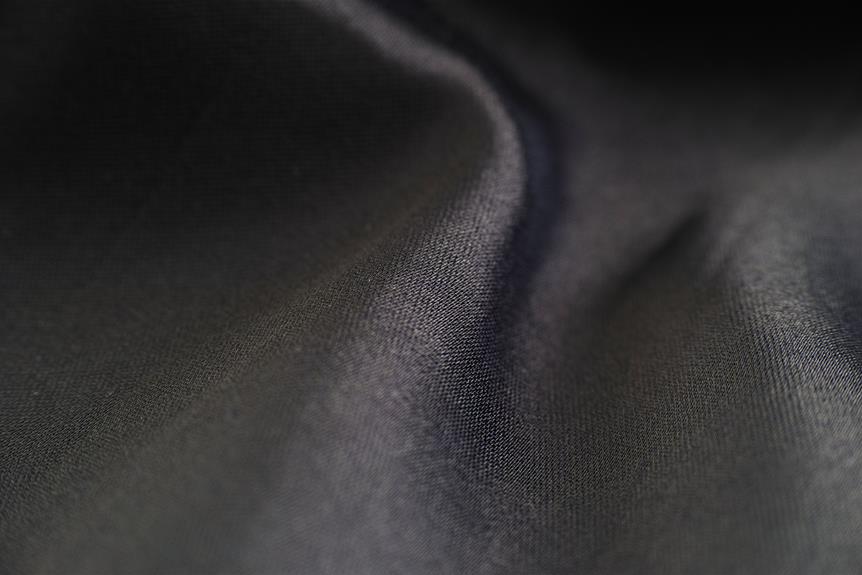Concerned about ruining the luxurious feel of your velvet fabrics with Scotchgard? You're not alone. However, understanding the safety of Scotchgard for velvet is crucial for preserving and protecting your upholstery. By delving into the science behind Scotchgard and its impact on velvet, you can make an informed decision.
This brief guide will provide you with expert insights, potential risks, and best practices for applying and maintaining Scotchgard on velvet fabrics. So, before you dismiss the idea, let's explore whether Scotchgard is truly safe for your cherished velvet possessions.
Key Takeaways
- Scotchgard creates a protective barrier on velvet fabrics, repelling liquids and blocking stains without compromising the fabric's breathability or appearance.
- There are potential risks and safety considerations when applying Scotchgard to velvet, including texture alteration, discoloration, environmental impact, and health concerns. It is important to test on a small, hidden area and ensure the velvet is clean and dry before application.
- The compatibility between velvet and Scotchgard should be considered, as chemical interactions may affect the durability and quality of the fabric. Seek guidance from professionals and conduct a small test before applying Scotchgard.
- Scotchgard contains perfluorinated compounds (PFCs) that have been linked to developmental issues, cancer, and harm to ecosystems. Proper ventilation and protective gear should be used during application to minimize exposure and health risks. Alternatives like beeswax, vinegar, essential oils, or professional fabric treatments can be considered for velvet protection.
What Is Scotchgard and How Does It Work
Scotchgard is a water and stain repellent that forms a protective barrier on fabrics, helping to prevent spills and stains from setting in. This fabric protection is achieved through the use of fluorochemical technology, which allows the Scotchgard formula to penetrate the individual fibers of the fabric. By doing so, it creates an invisible shield that repels liquids and blocks stains from adhering to the fabric.
This process doesn't compromise the breathability of the fabric, nor does it alter its look or feel.
The key to Scotchgard's effectiveness lies in its ability to coat each fiber without clogging the weave, ensuring that the fabric remains soft and breathable while providing reliable stain prevention. This advanced protection helps fabrics maintain their original appearance for longer, making them easier to clean and maintain.
Whether it's a spill or a smudge, Scotchgard-treated fabrics are better equipped to resist stains, giving you peace of mind and allowing you to enjoy your favorite pieces without worrying about irreversible damage.
The Benefits of Using Scotchgard on Velvet
Using Scotchgard on velvet can provide it with an extra layer of protection against spills and stains. This can be particularly beneficial for preserving the longevity of your velvet furniture and garments, ensuring they remain in top condition for years to come.
Here are some key benefits of using Scotchgard on velvet:
- Stain Protection: Scotchgard forms a protective barrier on velvet, preventing spills from immediately soaking in and causing stains.
- Easy Cleanup: With Scotchgard, spills bead up on the surface of the velvet, allowing for easier and quicker cleanup without leaving permanent marks.
- Extended Longevity: By safeguarding against stains, Scotchgard helps to maintain the pristine appearance of velvet, ultimately extending its lifespan.
- Versatility: Whether it's a velvet sofa, chair, or clothing, Scotchgard can be effectively applied to various velvet items, offering consistent protection.
- Simple Application: Applying Scotchgard to velvet is a straightforward process that can be easily done at home, providing convenience and peace of mind for velvet owners.
Potential Risks of Applying Scotchgard to Velvet
When considering the application of Scotchgard to velvet, it's important to be aware of the potential risks involved to make an informed decision about protecting your velvet items. While Scotchgard offers benefits, it's crucial to understand the potential downsides. Here are some risks and precautions to consider:
| Potential Risks | Precautions |
|---|---|
| Alteration of Texture | Test on a small, hidden area before full application. |
| Discoloration | Ensure the velvet is clean and dry before applying Scotchgard. |
| Environmental Impact | Look for eco-friendly alternatives or professional treatments. |
| Health Concerns | Wear a mask and gloves during application in a well-ventilated area. |
To maintain your velvet items after applying Scotchgard, follow the manufacturer's instructions and consider professional treatments for thorough maintenance. If you're concerned about the environmental impact or potential health risks, explore eco-friendly alternatives or seek professional treatments that adhere to safety standards. Taking these precautions can help you make an informed decision about protecting your velvet items while minimizing the potential risks associated with Scotchgard application.
Understanding the Safety of Scotchgard for Velvet
When it comes to understanding the safety of Scotchgard for velvet, it's important to consider the compatibility between velvet and Scotchgard. By exploring these points, you can make an informed decision about whether Scotchgard is safe for your velvet fabrics and how to best protect and maintain them.
The benefits of Scotchgard treatment for velvet are another important aspect to consider. Scotchgard can help to repel stains and spills, making it easier to clean and maintain your velvet items. This can prolong the life of your velvet fabrics and keep them looking their best.
However, it's also important to take into account the potential health considerations associated with using Scotchgard on velvet fabrics. Some people may be sensitive or allergic to the chemicals used in Scotchgard, so it's important to test a small, inconspicuous area of your velvet fabric before applying it to the entire item. Additionally, it's recommended to use Scotchgard in a well-ventilated area to minimize exposure to fumes.
Velvet and Scotchgard Compatibility
You can assess the compatibility of Scotchgard with velvet by understanding the safety of Scotchgard for velvet fabrics.
When considering the use of Scotchgard on velvet, it's important to evaluate its impact on the fabric's texture and appearance. Here are some factors to consider:
- Chemical Interactions: Scotchgard contains chemicals that may react differently with velvet compared to other fabrics.
- Long-Term Effects: Consider how Scotchgard may affect the long-term durability and quality of the velvet fabric.
- Application Technique: The method of applying Scotchgard to velvet can influence its compatibility and effectiveness.
- Professional Advice: Seek guidance from professionals experienced in treating velvet with fabric protection alternatives.
- Testing: Conduct a small test on a hidden area of the velvet to gauge the impact of Scotchgard before applying it to the entire fabric.
Benefits of Scotchgard Treatment
Considering velvet's delicacy, Scotchgard treatment offers a protective shield against stains and spills, preserving the fabric's luxurious appearance and feel. The benefits of Scotchgard treatment are numerous, including enhancing the longevity and durability of velvet fabrics. It is highly effective in repelling liquids and preventing stains, thus maintaining the pristine look of your velvet upholstery or apparel. In addition, Scotchgard is designed for easy removal if necessary, without causing damage to the fabric. Moreover, the reapplication of Scotchgard can further extend the protective properties, ensuring your velvet items remain resistant to spills and stains for an extended period. To help you visualize the benefits, here is a table summarizing the advantages of Scotchgard treatment for velvet fabrics:
| Benefits | Description |
|---|---|
| Longevity | Extends the lifespan of velvet fabrics by protecting against stains and spills |
| Durability | Enhances the fabric's ability to withstand everyday use and maintain its luxurious appearance |
| Effectiveness | Highly effective in repelling liquids and preventing stains |
Health Considerations for Scotchgard
Understanding the safety of Scotchgard for velvet involves examining its potential impact on human health. When considering the health risks associated with Scotchgard, it's important to note the following:
- Chemical Exposure: Scotchgard contains perfluorinated compounds (PFCs) which have been linked to adverse health effects, including developmental issues and cancer.
- Respiratory Concerns: When Scotchgard is applied, it can release harmful fumes that may lead to respiratory problems upon inhalation.
- Environmental Impact: The chemicals in Scotchgard can persist in the environment and accumulate in organisms, posing a threat to ecosystems and wildlife.
- Toxicity: PFCs have been found to be toxic to aquatic life, potentially causing harm to aquatic ecosystems.
- Safe Application: Proper ventilation and protective gear should be used when applying Scotchgard to minimize exposure and health risks.
Considering these factors is crucial when evaluating the safety of Scotchgard for velvet fabrics.
How to Apply Scotchgard to Velvet Fabrics
To effectively apply Scotchgard to velvet fabrics, start by laying the fabric flat and spraying an even coat over the entire surface. It's important to hold the can about six inches away from the fabric to ensure an even application. Be sure to protect surrounding areas from overspray by covering them with a drop cloth or newspaper. Allow the first coat to dry for at least two hours before applying a second coat for maximum protection. After the second coat, let the fabric dry completely for 24 hours before using or handling it.
When applying Scotchgard to velvet fabrics, it's crucial to test a small, inconspicuous area first to ensure the product doesn't affect the fabric's color or texture. Additionally, be mindful of ventilation and avoid inhaling the spray mist. If you're looking for alternatives to Scotchgard, consider professional fabric protection services or other fabric protectors specifically designed for delicate materials like velvet.
Always follow the manufacturer's instructions for the best results and consult a professional if you're unsure about the application process.
Tips for Maintaining Scotchgard-Treated Velvet
After applying Scotchgard to your velvet fabric, it's essential to take proactive steps to maintain its protective treatment and preserve the fabric's quality.
Here are some tips for maintaining Scotchgard-treated velvet:
- Regular Vacuuming: Vacuum your velvet fabric regularly to remove dust, dirt, and debris that can compromise the effectiveness of the Scotchgard treatment.
- Immediate Stain Removal: Promptly blot any spills on the velvet fabric with a clean, absorbent cloth to prevent stains from setting in. Follow up with gentle cleaning using a mild detergent and water.
- Avoid Abrasive Cleaning Methods: Refrain from using harsh chemicals or abrasive cleaning methods on the velvet fabric, as these can degrade the Scotchgard treatment over time.
- Professional Cleaning: Consider professional cleaning for heavily soiled velvet fabrics. Professional cleaners can effectively remove dirt and stains while preserving the long-term effectiveness of the Scotchgard treatment.
- Reapplication of Scotchgard: Monitor the fabric for signs of reduced water repellency, and reapply Scotchgard as needed to maintain its protective qualities.
Alternatives to Scotchgard for Velvet Protection
Looking for alternatives to Scotchgard for protecting your velvet fabrics?
There are natural fabric protectors available that are safe for both the fabric and the environment.
Additionally, professional fabric treatments provided by upholstery specialists can offer long-lasting protection tailored to the specific needs of your velvet furniture.
Natural Fabric Protectors
Consider natural fabric protectors as alternatives to Scotchgard for safeguarding your velvet fabrics. Eco-friendly alternatives and DIY fabric protection methods can provide effective protection without the use of harmful chemicals. Here are some natural fabric protectors to consider:
- Beeswax: A natural waterproofer that can be applied to velvet fabrics to repel liquids.
- Vinegar: Mix vinegar with water and spray it on velvet to protect against stains and odors.
- Essential Oils: Certain essential oils such as lavender, tea tree, or eucalyptus can act as natural protectants for velvet fabrics.
- Cornstarch: Sprinkling cornstarch on velvet and letting it sit before brushing it off can help absorb oils and prevent stains.
- Baking Soda: Another natural absorbent, baking soda can be used to protect velvet from spills and odors.
These natural alternatives can help you protect your velvet fabrics while being mindful of the environment and your health.
Professional Fabric Treatments
When protecting velvet fabrics, you may want to explore professional fabric treatments as alternatives to Scotchgard for effective and safe protection. Professional fabric treatments offer a high level of fabric protection, often surpassing consumer-grade products like Scotchgard. These treatments are designed to provide long-lasting protection against stains, spills, and soiling while maintaining the luxurious look and feel of velvet fabrics.
Unlike DIY solutions, professional application ensures even coverage and deep penetration into the fabric fibers, maximizing the protective effects. Additionally, professional-grade products are formulated to meet industry standards for safety and environmental impact.
When considering fabric protection for your velvet items, consulting with a professional fabric treatment specialist can provide valuable insights and ensure the best care for your delicate fabrics.
Expert Recommendations for Velvet Care and Protection
How can you effectively protect and care for your velvet fabrics? Velvet is a luxurious fabric that requires special care to maintain its beauty and texture. Here are some expert recommendations to help you keep your velvet fabrics in top condition:
- Regular Vacuuming: Use a soft brush attachment to gently vacuum your velvet fabrics. This will help remove dust and debris that can cause wear and tear over time.
- Spot Cleaning: Address spills and stains promptly with a clean, dry cloth. Gently blot the affected area to absorb the liquid without rubbing, which can damage the delicate fibers.
- Steam Cleaning: Consider professional steam cleaning for a deeper clean. This can help remove embedded dirt and revitalize the velvet pile.
- Avoid Direct Sunlight: Protect your velvet fabrics from direct sunlight, as prolonged exposure can cause fading and deterioration of the fabric.
- Rotate Cushions: If your velvet fabrics are used in upholstery, rotate the cushions regularly to ensure even wear and prolong the life of the fabric.
Frequently Asked Questions
Are There Any Specific Types of Velvet That Should Not Be Treated With Scotchgard?
When it comes to types of velvet, not all can handle Scotchgard. Some delicate velvets, like silk or antique velvet, may not be suitable for treatment. Always check with a professional for recommended products and velvet care.
Can Scotchgard Cause Discoloration or Change the Texture of Velvet Fabrics?
Yes, Scotchgard can affect color fastness and texture preservation of velvet fabrics. It's important to test it on a small, inconspicuous area first. Consider seeking professional advice to ensure the best results.
Is It Safe to Use Scotchgard on Antique or Vintage Velvet Pieces?
Using Scotchgard on antique or vintage velvet pieces has pros and cons. It can protect against spills and stains, but improper application may alter the fabric's texture. Follow careful application techniques to ensure best results.
What Should I Do if I Accidentally Spill Something on My Scotchgard-Treated Velvet?
If spills happen on your Scotchgard-treated velvet, act fast. Blot the spill with a clean cloth, avoiding rubbing to prevent spreading. Use a mild cleaning solution and gently dab the stained area. Always test in a hidden spot first.
Can Scotchgard Be Used on Velvet Upholstery as Well as Clothing?
Yes, you can use Scotchgard on velvet upholstery and clothing for fabric protection, but consider alternatives for velvet care and maintenance. Research and test products to ensure they are safe for your specific velvet fabric.
- Identifying Velvet Fabric: Fiber Content, Weave & Quality Indicators - June 22, 2025
- Types of Velvet Fabric: A Comprehensive Guide to Variations & Textures - June 22, 2025
- Creative Projects With Velvet Fabric: DIY Ideas & Inspiration - June 22, 2025







